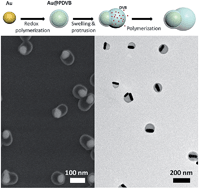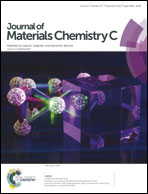Harnessing nonlinear rubber swelling for bulk synthesis of anisotropic hybrid nanoparticles†
Abstract
Asymmetric hybrid nanoparticles are at the forefront of colloidal chemistry as building blocks for novel structures and applications, as well as for exploring fundamental ways of breaking symmetry in physical systems. Current methods of synthesis have significant limitations in terms of control over synthesis, particle size ranges and polydispersity. We report a facile and scalable synthesis based on the anisotropic swelling of rubber to obtain metal–(polymer rubber) hybrid nanoparticles. Initial Au nanoparticle (NP) seeds are grown larger by reducing HAuCl4 with divinyl benzene (DVB), while simultaneous radical polymerization of DVB forms a cross-linked rubber layer of PDVB on the Au NP surface. The propensity of rubber to swell nonlinearly in the presence of DVB monomers amplifies initial asymmetries to break the symmetry of the PDVB shell, causing growth of asymmetric protrusions on one side of the core–shell particles, which are fixed by further polymerization. Plasmonic absorption of Au allows us to follow the Au reduction reaction and also suggests potential applications of some of the asymmetric particles in plasmon-enhanced sensing. The polydispersity, determined statistically from TEM and SEM images, of the resulting particles is low (<10%) and their sizes, shapes and metal–polymer ratios are easily tunable.


 Please wait while we load your content...
Please wait while we load your content...